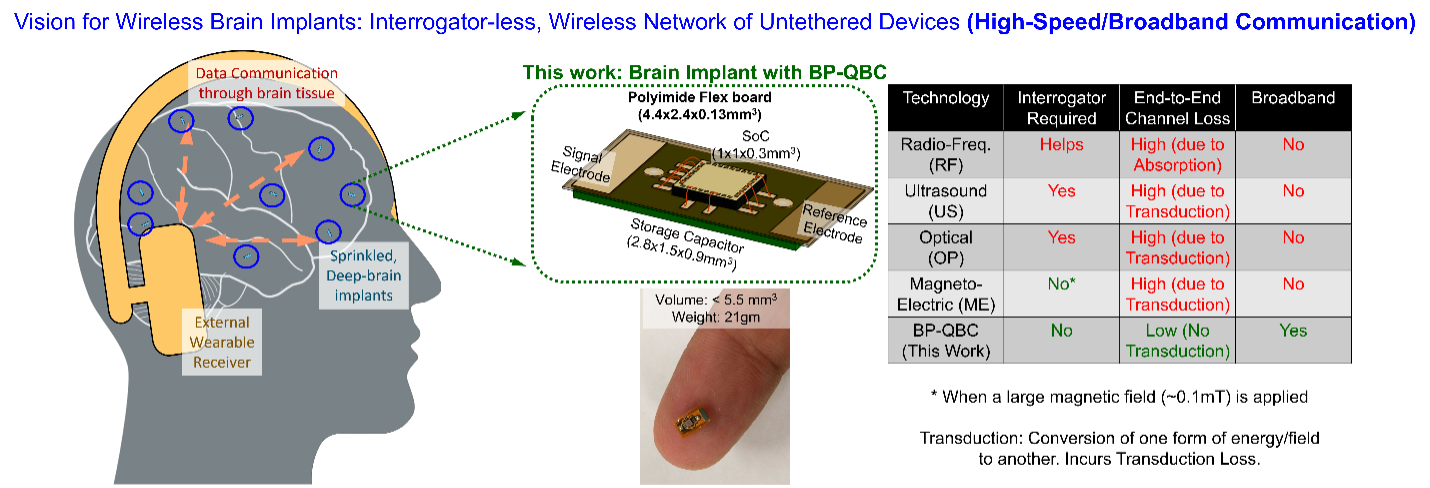A recent publication in Nature Electronics highlights work on extremely energy-efficient broadband communication in distributed wireless brain implants spearheaded by ECE Florida Assistant Professor Baibhab Chatterjee. The research has the potential to revolutionize our understanding of neurological and behavioral disorders.
The work, begun when Chatterjee was a doctoral student at Purdue University, working with Dr. Shreyas Sen, came to fruition after Dr. Chatterjee’s arrival at UF in 2022. The article presents the techniques required to create ultra-low power wideband/broadband data communication links, using the conductive properties of the brain tissue, for wireless neural implants placed deep inside the brain (at 5-6 cm depth). This work has already garnered significant interest in the community, and has already been covered by technical news agencies such as TechXplore and Front Matter.
Dr. Chatterjee was awarded the the prestigious Eaton Award in Design Excellence by Purdue University for his contribution to this work. A News Release from Purdue can be found here.
The Work
The focus of Chatterjee’s research was on designing an ultra-low power, yet high-data rate wireless microdevice, with a vision of creating a distributed network of deep brain/neural implants with minimal end-to-end system loss for data communication, a task that has posed significant hurdles in the past. The solution proposed by Chatterjee and Sen, which utilizes the conductive properties of biological tissue for signal transfer, has the potential to revolutionize our understanding of neurological and behavioral disorders.
The interdisciplinary nature of the work required combining principles from biological science, physical tissue properties, electromagnetics, electronics, and bio-electrical safety, which resulted in a novel device design approach that seeks to harness the potential of distributed micro-implants in the brain and/or the nervous system.
“Such technologies, when combined with advancements in deep-brain wireless power transfer, would make it possible to gain fundamental insights into disorders like Parkinson’s disease, Tourette Syndrome, Epilepsy, Depression, Anxiety, and obsessive-compulsive disorder,” Chatterjee said.
The traditional methods of wireless communication in brain implants rarely considers implant depths of more than 2 cm due to substantial end-to-end system loss. On the other hand, wired connections pose a considerable amount of risks for prolonged use, leading to cortical scarring, gliosis and even cerebrospinal fluid leakage. The research performed by Dr. Chatterjee presents a fully electrical wireless solution that does not suffer from transduction losses experienced by some of the competing technologies (ultrasound, optical, magneto-electric), and leverages the conductive properties of the brain tissue, especially up to 10s of MHz frequencies, where such signals are deemed Electro-quasistatic (EQS). With high impedance termination techniques at the receiver side, the channel loss for EQS can be made flat-band, enabling the wideband/broadband data communication (10s of Mbps, leading to 10s of pJ/b or even better energy efficiencies). Furthermore, using a biphasic data transmission technique (instead of traditional galvanic), the power consumption was shown to reduce by orders of magnitude as compared to traditional techniques. This would enable future deep-brain implants to have a lower energy budget for a particular data rate, relaxing the requirements for energy harvesting.
Read the full paper at Nature Electronics.



